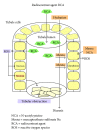Prophylaxis of contrast-induced nephrotoxicity
- PMID: 24812612
- PMCID: PMC4000949
- DOI: 10.1155/2014/308316
Prophylaxis of contrast-induced nephrotoxicity
Abstract
Contrast-induced nephrotoxicity (CIN) is a form of acute kidney injury that follows intravascular contrast media exposure. CIN may be preventable because its risk factors are well established and the timing of renal insult is commonly known in advance. However, contrast-induced nephrotoxicity is still the third leading cause of iatrogenic renal failure. This important complication accounts up to 10% of acute renal failure cases in hospitalized patients and it is associated with increased short- and long-term morbidity and mortality. Prolonged hospitalization follows and overall increases healthcare resource utilization. This paper will discuss the various prophylactic procedures tested in clinical trials.
Figures

Similar articles
-
Contrast-induced nephropathy: epidemiology and prevention.Minerva Cardioangiol. 2006 Feb;54(1):109-29. Minerva Cardioangiol. 2006. PMID: 16467746 Review.
-
[Iodinated contrast agent-induced nephropathy].Radiologe. 2007 Sep;47(9):761-7. doi: 10.1007/s00117-007-1549-x. Radiologe. 2007. PMID: 17823784 Review. German.
-
Contrast-induced nephropathy: pharmacological prophylaxis.Kidney Int Suppl. 2006 Apr;(100):S30-8. doi: 10.1038/sj.ki.5000372. Kidney Int Suppl. 2006. PMID: 16612399
-
Contrast nephrotoxicity.J Am Soc Nephrol. 1994 Aug;5(2):125-37. doi: 10.1681/ASN.V52125. J Am Soc Nephrol. 1994. PMID: 7993992 Review.
-
Contrast media induced nephropathy: definition, incidence, outcome, pathophysiology, risk factors and prevention.Minerva Med. 2008 Apr;99(2):177-96. Minerva Med. 2008. PMID: 18431326
Cited by
-
The association between hemogram parameters and the development of contrast-induced nephropathy in patients presenting with non-ST-elevation myocardial infarction.Adv Lab Med. 2023 Aug 14;4(3):308-313. doi: 10.1515/almed-2023-0037. eCollection 2023 Sep. Adv Lab Med. 2023. PMID: 38075170 Free PMC article.
-
Circulating Exosomal miR-1-3p from Rats with Myocardial Infarction Plays a Protective Effect on Contrast-Induced Nephropathy via Targeting ATG13 and activating the AKT Signaling Pathway.Int J Biol Sci. 2021 Mar 2;17(4):972-985. doi: 10.7150/ijbs.55887. eCollection 2021. Int J Biol Sci. 2021. PMID: 33867822 Free PMC article.
-
Efficacy and safety of a balanced salt solution versus a 0.9% saline infusion for the prevention of contrast-induced acute kidney injury (BASIC trial): a study protocol for a randomized controlled trial.Trials. 2017 Oct 5;18(1):461. doi: 10.1186/s13063-017-2202-2. Trials. 2017. PMID: 28982378 Free PMC article. Clinical Trial.
-
Acute kidney injury after contrast-enhanced examination among elderly.Rev Lat Am Enfermagem. 2014 Jul-Aug;22(4):637-44. doi: 10.1590/0104-1169.3440.2462. Rev Lat Am Enfermagem. 2014. PMID: 25296148 Free PMC article.
-
Histopathological Evaluation of Contrast-Induced Acute Kidney Injury Rodent Models.Biomed Res Int. 2016;2016:3763250. doi: 10.1155/2016/3763250. Epub 2016 Nov 16. Biomed Res Int. 2016. PMID: 27975052 Free PMC article. Review.
References
-
- Katzberg RW, Haller C. Contrast-induced nephrotoxicity: clinical landscape. Kidney International. 2006;69:S3–S7. - PubMed
-
- Nash K, Hafeez A, Hou S. Hospital-acquired renal insufficiency. The American Journal of Kidney Diseases. 2002;39(5):930–936. - PubMed
-
- Mehran R, Nikolsky E. Contrast-induced nephropathy: definition, epidemiology, and patients at risk. Kidney International. 2006;69:S11–S15. - PubMed
-
- Lasser EC, Lyon SG, Berry CC. Reports on contrast media reactions: analysis of data from reports to the U.S. Food and Drug Administration. Radiology. 1997;203(3):605–610. - PubMed
-
- Berg KJ. Nephrotoxicity related to contrast media. Scandinavian Journal of Urology and Nephrology. 2000;34(5):317–322. - PubMed
Publication types
MeSH terms
Substances
LinkOut - more resources
Full Text Sources
Other Literature Sources
Medical

